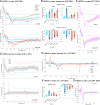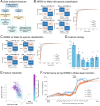Multi-night cortico-basal recordings reveal mechanisms of NREM slow-wave suppression and spontaneous awakenings in Parkinson's disease
- PMID: 38413587
- PMCID: PMC10899224
- DOI: 10.1038/s41467-024-46002-7
Multi-night cortico-basal recordings reveal mechanisms of NREM slow-wave suppression and spontaneous awakenings in Parkinson's disease
Abstract
Sleep disturbance is a prevalent and disabling comorbidity in Parkinson's disease (PD). We performed multi-night (n = 57) at-home intracranial recordings from electrocorticography and subcortical electrodes using sensing-enabled Deep Brain Stimulation (DBS), paired with portable polysomnography in four PD participants and one with cervical dystonia (clinical trial: NCT03582891). Cortico-basal activity in delta increased and in beta decreased during NREM (N2 + N3) versus wakefulness in PD. DBS caused further elevation in cortical delta and decrease in alpha and low-beta compared to DBS OFF state. Our primary outcome demonstrated an inverse interaction between subcortical beta and cortical slow-wave during NREM. Our secondary outcome revealed subcortical beta increases prior to spontaneous awakenings in PD. We classified NREM vs. wakefulness with high accuracy in both traditional (30 s: 92.6 ± 1.7%) and rapid (5 s: 88.3 ± 2.1%) data epochs of intracranial signals. Our findings elucidate sleep neurophysiology and impacts of DBS on sleep in PD informing adaptive DBS for sleep dysfunction.
© 2024. The Author(s).
Conflict of interest statement
S.L. has received honoraria from Medtronic and is a paid consultant for Iota Biosciences. T.D. is founder-chairman of MINT neurotechnology, founder/CSO of Amber Therapeutics (bioelectronic medicines), and a paid advisor for Cortec Neuro. T.D. has research collaborations with Magstim Ltd, Medtronic, and Bioinduction Ltd. S.L., C.S., P.S., M.F.A, and T.D. are involved in a pending patent application. Patent applicant: University of California San Francisco (UCSF); Inventors: S.L., C.S., P.S., M.F.A., and T.D.; Application number: 63/522,284; Status: Provisional; Specific aspect: Awakening detection and intracranial machine learning models for detection of awakenings.
Figures





Update of
-
Multi-night cortico-basal recordings reveal mechanisms of NREM slow wave suppression and spontaneous awakenings at high-temporal resolution in Parkinson's disease.Res Sq [Preprint]. 2023 Nov 7:rs.3.rs-3484527. doi: 10.21203/rs.3.rs-3484527/v1. Res Sq. 2023. Update in: Nat Commun. 2024 Feb 27;15(1):1793. doi: 10.1038/s41467-024-46002-7. PMID: 37986864 Free PMC article. Updated. Preprint.
References
MeSH terms
Grants and funding
LinkOut - more resources
Full Text Sources
Other Literature Sources
Medical

